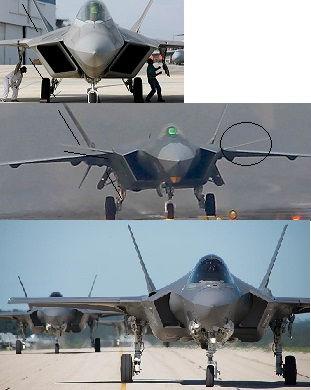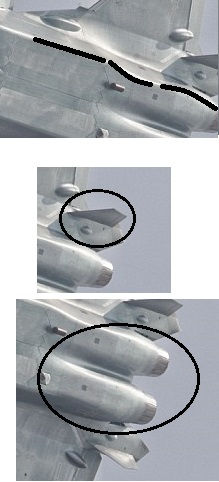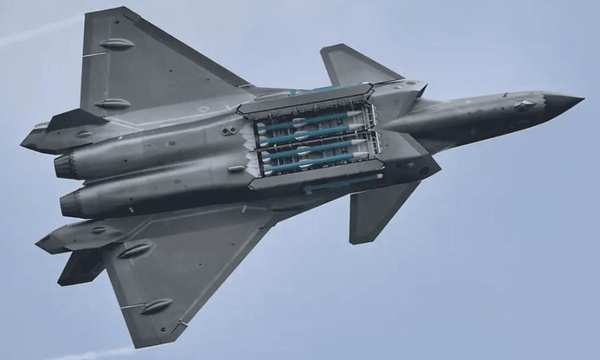Stealth
The J-20 has several aerodynamic solutions applied to the F-35, MiG 1:44, F-117, Rafale, HiMat and F-15 ACTIVE, these are cobbled together to create an aircraft with a personality of its own, however the use of canards limited the design and affected its stealth.
Su-57 for example used LEVCONs that can be used even for roll, basically controlling the vortex generated by the wing leading edge extensions, without the gap between canard and main wing, eliminating problems such as down wash, drag, position of the canard with respect the wing.
The use of ventral fins on the J-20 was due to the lack of thrust vectoring nozzles, further more, J-20 needed to reduce cross section at the rear of its fuselage to allow for area ruling affecting its stealth shaping.
In general the J-20 follows the F-35 forward fuselage shaping, but the use of canards and ventral fins plus area ruling affected its stealth shaping more than in the F-22`s case
The RCS of an aircraft is determined by the magnitudes of two distinctly different contributions:- i) The size and shape, both overall and in detail. ii) The electromagnetic properties of the airframe materials.
It is useful to note the relative contributions to RCS of the various effects in the case of a conventional aircraft, since this indicates the areas where most improvement is possible. Large contributions may be expected from:- Air inlets for engines Engine front faces, if intakes are straight External stores, Including missiles with nose mounted seekers Wing leading edge, especially if unswept Corner reflectors at intersections of horizontal and vertical tails Wing from directly below Radome, if transparent to illiminating radar Cockpit, including cavity effect Powerplant exhausts, when viewed from rear Flat, slab sided fuselage from normal to its side Smaller, but nevertheless significant contributions arise due to Fuselage, in head on view Wing trailing edge and control surface gaps Local air intakes, e.g. for cooling or conditioning Local surface protuberances Vertical and horizontal tails in isolation Long, thin fairings or missile.
One of the largest contributions to airframe RCS occurs any time a relatively flat surface of the aircraft is perpendicular to the incoming radar beam. To prevent these RCS "spikes," the designer may slope the fuselage sides, angle the vertical tails, and so on, so that there are no flat surfaces presented towards the radar
If the aircraft is primarily designed for low detectability by a nose-on threat radar, the wings and tails can be highly swept to reduce their contribution to RCS.

This front view of J-20 and Rafale shows the J-20 has a canard in the less than ideal position, it is a high-mounted canard where the wing root chords of the canard and wing are coplanar, contrary to the Rafale that has a high canard where the canard wing chord is above the main wing root chord.
To summarize Rafale has a mid-mounted wing with a high mounted canard, while J-20 has a high-mounted wings and high-mounted canards.
On the Chinese fighter the canard has dihedral to improve the position the vortices shed by it are with respect the wing, while this will be better than the canard of X-36 which is a coplanar one.
It is obvious the Chinese jet has not the best position for its canard, however this was made trying to harmonize stealth with aerodynamics
1. In general, the effect of canard sweep on lift is small up to an angle of attack of 16 deg. However, for angles of attack greater than 16 deg, increasing the canard sweep results in an increase in lift developed by the canard for the canard above or in the wing chord plane. This increased lift results in a lift increase for the total configuration when the canard is above the wing chord plane. For the canard in the wing chord plane, the increased canard lift is partially lost by increased interference on the wing. 2. For the configurations with the canard in the wing chord plane, increasing the canard dihedral angle from -18.60 to 18.60 degrees increased the maximum lift coefficient of the configuration. For the configurations with the canard above the wing chord plane, the highest maximum lift coefficient was developed when the canard had no dihedral.
THE EFFECT OF CANARD LEADING-EDGE SWEEP AND DIHEDRAL ANGLE ON THE LONGITUDINAL AND LATERAL AERODYNAMIC CHARACTERISTICS OF A CLOSE-COUPLED CANARD-WING CONFIGURATION by Blair B. Gloss Z Langley Research Center ' Hampton, Va. 23665

On the F-22, F-35, SU-57 and J-31 the horizontal stabilizer is hidden by the main wing and parallel to the main wing too so it keeps the planform alignment thus helping stealth.
J-20`s canard is an extra reflecting surface from a frontal view by not being hidden by the main wing, it is neither parallel with the wing or the vertical stabilizer, therefore it is breaking planform alignment, further more F-22 has thrust vectoring for trimming during cruise flight, J-20 has not thrust vectoring forcing the canard to deflect more during cruise flight, thus J-20 is not as stealthy as F-22 or even X-36.
On X-36 the canard does not have dihedral and it keeps planform alignment by being coplanar with the wing
let us see this article:
Since all configurations have the same fuselage, dorsal intake and vertical empennage, the explanation of the RCS signature reduction for the Standard delta with LEX and Double delta is due to the planform of the configurations. Note that Standard delta with LEX and Double delta have different leading edges sweep, which enhances survivability by the non-uniform fringe surfaces. By last, canards can potentially have poor stealth characteristics due to their large and angular surfaces that tend to reflect radar signals forwards.
EVALUATION OF DELTA WING EFFECTS ON THE STEALTH-AERODYNAMIC FEATURES FOR NON-CONVENTIONAL FIGHTER AIRCRAFT
Canards are also a good way to increase radar cross section and compromise the other stealth features. Unless the canards have to be on the same plane with the wings, they would significantly contribute to increase RCS regardless they are moving or not from 12 o'clock head on. And even if it's being aligned with the wings on the same plane and angles both horizontally and vertically, it would still contribute to increasing RCS nonetheless from a diagonal view.
https://www.globalsecurity.org/military/world/china/j-20-design.htm
In the control-canard, most of the weight of the aircraft is carried by the main wing and the canard wing serves primarily as the longitudinal control device. A control-canard could be all moving or could have a large elevator. The control-canard has often higher aspect ratio and employs a thicker airfoil section than a lifting-canard. A control-canard mostly operates at zero angle of attack. Fighter aircraft with a canard configuration, such as Eurofighter Typhoon (Figure 3.7), typically have a control-canard. One benefit obtainable from a control-canard is avoidance of pitch-up. An all-moving canard capable of a significant nose-down deflection will protect against pitch-up. Control canards have poor stealth characteristics, because they present large moving surfaces forward of the wing
http://www.aero.us.es/adesign/Slides/Extra/Stability/Design_Tail/Chapter%206.%20Tail%20Design.pdf
Compared with the conventional layout where the horizontal tail is placed at the rear, the canard is installed in front of the main wing, which is like installing a huge horn headlight and is easily noticed in dark and open areas. This is because, for the movable canard, the gap caused by the movement between it and the fuselage is directly exposed to the radar detection in front of the aircraft, increasing the possibility that the RCS characteristics of the fuselage are detected simultaneously [5]. But for the horizontal tail, which is located behind the main wings, the main wing blocks approximately most of the gaps that are prone to exposure risks when the horizontal tail moves, which greatly reduces the possibility of being detected by radar from the front. Therefore, conventional layout aircraft are ahead of canard layout aircraft in stealth

J-20 has uneven surfaces after its side weapons bays and round engine nacelles,to reduce cross section and follow the Whitcomb area rule aerodynamic principles, plus Chengdu fitted the J-20 with ventral fins for lateral. and directional stability because the dorsal V tail was not enough for controlling the aircraft at high Angle of attacks; however this generates resonance and radar signature for ground radar. These features also reduced its stealth features.
China lacks Thrust vectoring, contrary to Russia or the USA, so they were forced by limitations to break the stealth technology rules and prioritize aerodynamics, thus Chengdu set the canards with dihedral and fitted the J-20 with ventral fins.
Would have Chengdu used LEVCONs on J-20 and thrust vectoring the machine would had kept stealth and performance at the same time, but the V vertical tail it has can not work as the single pitch authority aerodynamic control so they added canards and ventral fins.

J-20 used a design fashion from basically the mid-1990s, it incorporates ideas of that time, however Airbus is designing a jet that has fixed all the contradictions Chengdu could not fix, among them the deletion of the canards and ventral fins and their substitution by LEVCONs and a tailless compound wing with a long Leading edge extension.
Furthermore Thrust vectoring can also be used to reduce the radar cross section (RCS) of very low-observable aircraft by removing the need for conventional aerodynamic control surfaces this will increase the speed that it gives to the aircraft in supercruise.
Studies claim it can increase 7% more thrust in supercruise.
This is the case of F-22, and T-50/Su-57, the speed increases the enemy's problem by reducing the time allowed to detect, lock on, launch and fire the missile at these stealth aircraft.
Aircraft experience a loss of control effectiveness at supersonic speeds. In order to generate the same maneuver supersonically as it is done subsonically, the controls must be deflected further. This will result in a big increase in supersonic trim drag and a subsequent loss in acceleration and turn performance; J-20 by lacking thrust vectoring will remain more of a subsonic fighter and less capable than the American and Russian stealth fighters.
Furthermore the Diverterless Supersonic Intake has an average total pressure recovery coefficient at the exit of bump inlet of nearly 0.87 at its design Mach number of 2.0,and no less than 0.91 at mach number of 1.8.
If the rule of thumb is used we can consider that for 1% of pressure loss it will reduce thrust by 1%, Nevertheless thrust loss caused by pressure losses in supersonic flight increases nonlinearly; and at a flight speed of Mach 2.2, a typical engine is losing 8% of the freestream total pressure through the intake, thus it will suffer a reduction in thrust of 13% and a 5% increase in fuel consumption.
Therefore we can not expect it will be able to match the F-22 and Su-57 at supersonic speeds
The advantages of thrust vectoring are for
F-22
Control capabilities
Enhance pitch control
Free Horizontal tails at high AoA
Decrease field length
Optimize subsonic and supersonic maneuvering performance
Post-stall maneuvering and nose pointing ability

A fighter aircraft achieves low aerodynamic drag and radar signature without sacrificing flight performance through a unique arrangement of the main weapons bay, the auxiliary weapons bays, and the main landing gear. Separate main and auxiliary weapons bays permit a narrower fuselage than could be obtained with a single common bay. Also, the auxiliary weapons bays and the landing gear can be aligned outboard of the main weapons bay without needing to increase the length or width of the aircraft. The air intake ducts extend aft from the intake and curve upwardly and inwardly over the main weapons bay. The result of the design configuration is an aircraft which has a forward aspect reduced to the minimum necessary to accommodate the components that need forward visibilities, which translates to minimum aerodynamic drag and radar signature.
It is often not possible to confine the frontal aspect of fighter airplanes to the combined frontal aspects of the canopy, the radar dome and the engine air inlets. For example, fighter airplanes can accommodate an adequate weapons load only by using two alternative techniques, both of which impose undesirable drag and signature penalties. First, the weapons can be carried externally, generally by attaching them to external pylons.
However, carrying the weapons externally creates a great deal of drag, and the exposed weapons enlarge the signature of the aircraft. Second, the weapons can be carried in an internal weapons bay, traditionally located along the bottom of such airplanes. Carrying weapons in an internal weapons bay avoids the drag and radar signature penalties incurred in carrying the weapons externally. However, an adequate weapons load often can be carried only by using relatively wide weapons bays which have a tendency to make the frontal aspects of such airplanes larger than the combined frontal aspects of the canopy, forward-looking radar dome and engine air inlets. Thus, regardless of which conventional technique is used, adequate weapons loads generally can be carried only by increasing the aerodynamic drag and radar signature of such aircraft.
Inventor
Current Assignee
Boeing Co
Fighter aircraft having low aerodynamic drag and low radar signature configuration
https://patents.google.com/patent/US5522566A/en